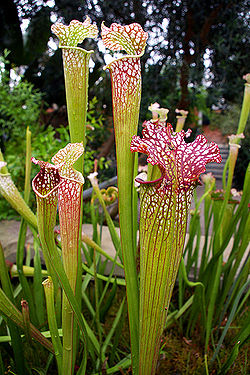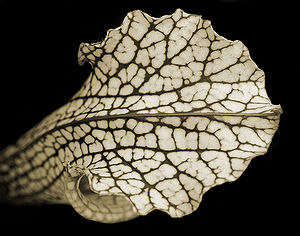Pitcherplant
| Pitcherplant |
|---|

|
| Scientific Classification |
|
| Species |
|
Pitcherplants are any of the species of carnivorous plants belonging to the taxonomic genus Sarracenia. When one thinks of a carnivorous plant, it is natural to think of a more common choice such as the Venus fly trap, but the pitcherplant works quite differently. The pitcherplant was created to capture prey without movement. It is named well, as it highly resembles the shape of a pitcher or a cup. This cup is filled with digestive enzymes that engulf an insect or small rodent.
"Ask of Yahweh rain in the spring time, Yahweh who makes storm clouds, and he gives rain showers to everyone for the plants in the field." Zechariah 10:1
Anatomy
The pitcherplant, is also known as the “North American Pitcher,” or Sarracenia. As the name suggests, the leaves of the Sarracenia are shaped like a long cup, or “pitcher.” The pitcherplant has this unique shape so that insects are drawn to the smell of its nectar then are dragged to and drowned in the bottom of the pitcher.[1] The pitcher plant has a hood which makes the nectar that lures flies and other bugs into the pitcher and also keeps out unwanted water from getting inside. The pitcher is filled with enzymes designed to break down tissues necessary to the plant for survival.
Insects, (either crawling or flying) reach the pitcher opening due to attraction by the sweet smelling nectar that fills the beautifully crafted pitcher. The hood of the pitcher plant is required to be colorful because it needs to be attractive to insects. It is colored by anthocyanins that change the pitcher to a shade of purple,which deceives bugs into thinking it is an ordinary flower. [2] This hood acts as a surface landing. The bottom of the lid also has numerous nectar secreting [glands] to appeal to the prey.
Although by looking at the pitcher plant one would suggest that the umbrella would shut in the prey as the Venus flytrap does, but the lid’s purpose is simply to keep out unwanted water. Once an insect falls into the pitcher, it is virtually impossible to escape, even if they are equipped with wings. The inside of the pitcher is slippery due to a waxy coating. This confuses trapped prey because they bounce between the walls, fall, and become trapped in the nectar found at the bottom. [3]
The nectar found inside of the pitcher has been found to paralyze small insects such as ants and mosquitoes. This nectar is also called phytotelma, which damages the bugs’ wings. The Sarracenia can sense when prey is trapped inside by small movements of the insect and forces the plant to excrete digestive acids. Some Sarracenia have been noticed to have a negative odor. The trapped bugs inside the plant that are being digested cause this odor. Other bugs can smell this odor and avoid the plant. [4] when Sarracenia take too long to digest an insect, it can cause severe pitcher damage.
Reproduction
The flowers of the Sarracenia plant are monecious and can reproduce by sexual or asexual reproduction. Bees mainly pollinate these flowers if there are multiple flowers to attract them. A seed can be formed in the ovary by a pitcher plant’s pollen being moved to a pistil or by fragmentation of rhizomes. The seeds are released by the flowers and are nurtured by bare ground. [5],[6] When these seeds are still in their growing phase, they are covered by sepals.[7] After the seeds have germinated, seedling leaves sprout and form small pitchers. These pitchers grow to be about an inch tall by winter and pause growth (although they look withered) for the winter and begin growth again in the spring . When spring resumes, the pitcherplant regrows it’s flowers and then reproduces its pitchers. To ensure pitchers in the next season, the nutrients are stored in the leaves during the off season. [8]
Proverbs 27:25 "The hay is removed, and the new growth appears, the grasses of the hills are gathered in,"
Ecology
A pitcherplant’s habitat is very far ranging. Naturally, they can be found mostly in wetlands and reach from Canada to some southern states. Pitcherplants can stay green all year by living in areas like these. These carnivorous plants need nitrogen and molybdenum and cannot get it from soil in wetlands, this is why they rely on digesting insects for these nutrients. Sarracenia, like most plants, need an adequate amount of sun each day. The pitcherplant needs an average of 6 hours a day. Pitcherplants are also common to be found in gardens and residential areas.[9]Ordinarily fire is looked at as a negative occurrence in a plant’s habitat, but for a pitcherplant, this is untrue. Fire is completely essential to Sarracenia because of their need for sun and fire destroys plants that could be blocking sunlight from reaching them. Fire also destroys plants that absorb moisture from the soil that Pitcherplants need for survival. [10]
Example Species
S. alata - the “Yellow Trumpets”. Has light green leaves with red veins and pale, unscented yellow flowers. Is 26 or more inches tall.
S. flava – Yellow with yellow flowers.
S. leucophylla - the White-topped pitcher. Has red and green veins and dark red flowers.
S.minor - the Hooded Pitcher plant. between 6 to 10 inches tall and have yellow flowers and small, clear window-like openings to confuse creatures trapped inside.
S. psittacina – called the “Parrot” Pitcher Plant. Tear drop shaped pitchers and get their name because they look like a parrots head from a side angle. The parrot pitcher has red flowers and red veined leaves. Survive well in wind and when immersed in water can capture prey through an opening in the umbrella.
S. purpurea – purple with red veins, flowered with pink “rosettes”. When exposed to cold weather the s. purpurea turns a burgundy color.
S. purpurea ssp. venosa var. burkii – about 10 to 12 inches. this species has a wider pitcher and a pale colored hood. The flowers are pink and found in the south.
S. rubra subspecies rubra - typical North Carolina form- 5-7 inch tall green leaves with red veins and flowers.
S. rubra subspecies gulfensis- a yellowish green and range from 7 to 11 inches.
S. rubra subspecies wherryi- 8 inches tall with red veins and wide leaves. The flowers are dark red.
[11]
Videos
rodents use pitcherplant as toilet
Gallery
References
- [12] Julie Elefante, ehow.com
- [13] Barry Rice, June-2009, www.sarracenia.com
- [14]Regina Bailey, About.com
- [15] Pitcherplant.com
- [16] 26 February, 2004, www.rook.org
- [17] www.bioweb.uwlax.edu
- [18] Answers.com
- [19] www.sarracenia.com
- [20] Alissa Pond Mentzer eHow.com
- [21]Auburn.edu, 2002, The Longleaf Alliance









